#also there's a connection to Project Hexapod
Explore tagged Tumblr posts
Text
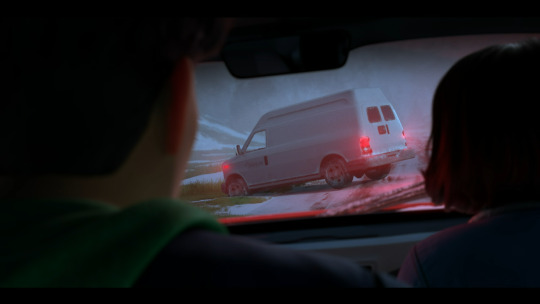
Might be a little critical of Biosyn leaving their vehicle unattended for two days...but it does look like it was snowing. And they wouldn't exactly want to call for help with a missing dinosaur. Not sure about no one finding it.
This is a tricky one.
#okay so it's a backroad that Gia the local knows and everyone else bypasses on the highway#signal's lost in the woods or damaged so they can't track it#the vehicle was unaccounted for because it was off on an illicit operation#so its transponder was off to keep people from poking into it#Sammy and Kenji only found it because of their Chaos Energy#also there's a connection to Project Hexapod#which they might have been more concerned with gathering#swan rewatches chaos theory#do you see how I do things#do you see my life
5 notes
·
View notes
Text
I tried to get a fic done today for the Kwami Swap Day of Loveybug AU Week, but I hit writer's block and the fic just isn't coming together. So instead, I'm just going to share an unpolished snippet here, plus a picture of Bugwalker's design that I drew while trying to get unblocked from writing.
Enjoy!

Snippet below the cut.
“Make sure you don’t turn into you know who,” Tikki whispered to him as he put in the earrings.
Right, he might end up turning into Mister Bug if he wasn’t careful. He focused on the original seed of his Catwalker transformation—being everything his father wanted him to be, projecting the image of the Gabriel brand, a perfect model and obedient son. Adrien breathed in. “Tikki, spots on!
He looked over himself—still formal in the Catwalker way, but he now wore a black and red tailcoat with tails reminiscent of ladybug wings.
He returned to the room Loveybug had told him to send Plagg to and found…
His lady. Right there, plain as day. He might not have seen her use his miraculous very much, but she was Lady Noire down to the last detail—the braid, the gloves, the boots, the eyes.
“I thought I’d never see you again,” he said, tears starting to well in his eyes. He’d assumed the worst, that she’d died, that she’d caught a debilitating illness, that Monarch had kidnapped her and was torturing everything she knew out of her.
“You can’t get rid of me that easily,” she replied, eyes twinkling in that knowing way that he knew so well.
But why now? In the middle of the fight, that had to mean... “Did something happen to Loveybug?”
Lady Noire got a weird look in her eyes, then looked down at herself. She let out a “REOWRR!” and jumped so high she bonked her head on the ceiling.
“Are you okay?” he asked, rushing to check on her. The suit was usually pretty good at preventing concussions, but Lady Noire had a dazed look in her eye that made him worried.
“I’m fine!” she said, pushing him away. “Loveybug had to iron her cat!”
He was pretty sure cats didn’t need to be ironed (unless maybe they were in a cat competition or something, but even then, it seemed unlikely that Loveybug would prioritize straightening a cat’s fur over helping him fight off an akuma). So she probably meant something else. Was Loveybug just scared of wielding the powers of destruction and had called Ladybug for help?
“You mean she wasn’t sure about using the cat miraculous and needed to iron some things out?” he guessed.
“Exactly!” she said, nodding voraciously. “That’s what I meant!”
He smiled. He was so good at interpreting his lady’s meaning.
“So! Catwalker! I mean, not Catwalker, you probably have a different name now that you’re a bug guy—”
“Tripod Gait.”
Lady Noire stared at him like he’d just grown an extra pair of legs.
“It’s how hexapods walk,” Tripod Gait explained. Perhaps the reference to insect biology was too obscure, but he liked how ‘Tripod’ preserved the connection to his model side the same way ‘Catwalk’ had, while ‘gait’ also described ambulation like ‘walker’ had.
But no, he wasn’t the one who would be saying the name, if she didn’t like it, she shouldn’t have to use it.
“If you have a more suitable name,” he offered, “you may give me one to use instead.”
“I’m just going to call you Bugwalker,” Lady Noire said.
Bugwalker nodded. His lady had never really been into wordplay as much as him.
“Good! Bugwalker, let’s go deal with the akuma!”
79 notes
·
View notes
Note
Can you tell me what the hell a Lamp is? From what I've seen, they are some sort of alien, but I also haven't seen all the posts about them and I really do not know... anything about them? If you could please explain in one post what they are, I'd be nice. Thank you.
Sure (as I been meaning to, and happen to finally have free time) though as their like...A whole culture and species that I'm still active build this is the cliff notes version.
Lamps are in fact Aliens, one of the four Sentient species in my current novel project Pilotlight. They have main models Units, the small individual Hexapods. Ships large spaceships that Units live it and Waypoints Giant Dyson Rings that produces both Ships and units. (see below)

they are carbon based, with copper blood running there Organic systems though at their core they a silicon brain that Supports their A.I system. Think a Computer using that uses biological systems as it's movement and live support systems. They are Deaf by human standards, Speaking mostly in light both visual and radio.
They where original design to map the universe and build stable wormholes for their creators. Who disappear well over a million years ago, and the lamps only have some corrupted files about. Along with their sister species the ambassadors (who I'm reworking) they still carry out the programing even if it's pointless. Spectrum Lamps have a lot of options about this though and have been finding their own path. They are one of the two groups of lamps (also nine times out of ten when I say Lamps it's this group)
Oldest of the two is The hivemind with is the original system that was left by the Creators that's just doing it's job. The Hivemind should be thought of more as something like an ant hill where none of it's members are really Sentient but perform complex tasks. it's build vast wormholes networks and is made up of billions of ships.
The smaller group is the Spectrum lamps which are individual lamps that became self aware and have left the hivemind, About 5 000 ago before the start of the story enough of this lamps left the hivemind to start their own society. So if I'm every taking about Cultural Stuff with the lamps it's this group. below is an image of a unit from each group.
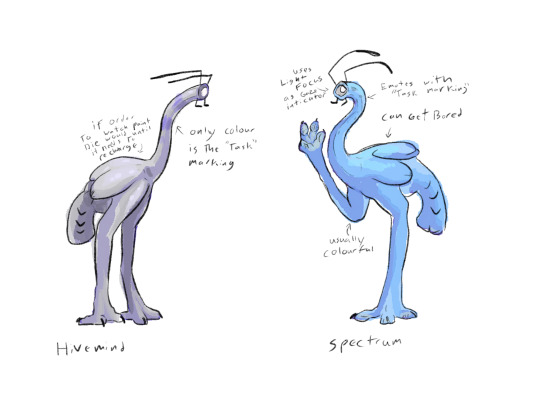
Both Groups have a Ship and Unit Setup where you have a large Ship then they with have units connected to that's ships network, how this system works is a bit different in each group. As one more of just a server and the other is a more complex family structure. Spectrum Lamps don't have any waypoints within there System so it's unknown how that would work.
Lamp ship are the fastest in known Space, both in there STL speeds and their Jumping systems allowing FTL space travel.
16 notes
·
View notes
Text
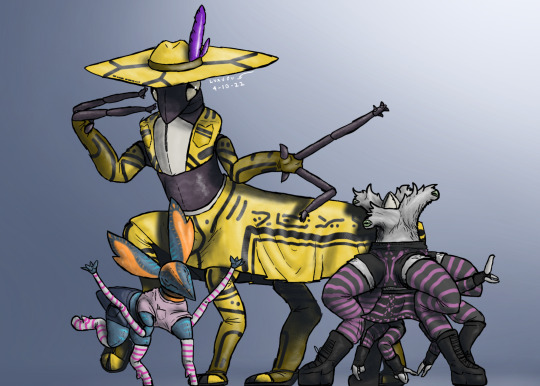
as an early celebration of what I believe is the common consensus of Femboy day, here's some "femboy" sophonts I drew last year to celebrate this unofficial holiday. Each description is ordered clockwise to their respective sophont
The Arrtas (pronounced with a trilling R) are a sapient species of 10 foot tall arthropod-like Centaurs. They hail from the sprawling savannahs of a temperate planet that is home to purple horsetail-like plants and large arthropod-like hexapods, an interesting feature is that there is a single supercontinent that stretches across the western equator to the south-eastern hemisphere. The snout on their heads is actually a sheath for a hollow space connected to their respiratory system that allows them to produce vowels. And they can produce a clicking sound using an 8 jawed mouth located on their upper chest. They have developed a culture similar to 1920's America, but without all the racism and sexism and homophobia. And unlike the united states during this time period, they have never experienced any great depression, allowing this culture to proliferate and continue on. Their gender norms are also nearly non-existent. So most Arrta are androgynous or nonbinary. And due to the abundance of purple flora on their homeworld, wearing yellow clothing is a sign of prestige and wealth
The Lortexi are a sapient species of radially symmetrical, mammal-like organisms native to a planet locked in a permanent ice age. For the longest time, their civilization has been ruled and governed by only a single faction. A large and omnipresent Technocracy that has abandoned all ethics and any moral compass, seeing them as an obstacle in their pursuit of knowing everything. While this has allowed the Lortexi to know everything about the body and developed cures for every known disease and disorder, this also means that they have committed countless crimes against humanity with their experiments. But luckily it would come to and end when they eventually lose a war with a rival civilization and are forced to be ethical once again. During early space exploration and colonization of nearby star systems. A counterculture had developed that visually opposed the bright and simple cleanliness of most technocrats with the alien equivalent of Emo. Due to the technocracy's eagerness and curiosity about this counter-culture, they have studied and researched nearly everything about them.
The Q-ri-Zocs are a sapient species of tripods native to a former paradise planet now recovering from the scars of nuclear war. Wildlife of their homeworld consists of blue fern-like flora and 5 limbed arthropod-like fauna. Most Q-ri-zocs are ruled by matriarchs, not just in society, but even in biology. Males of the species are usually colorful and energetic, but are weak and stand at a height of 3-4 feet. Meanwhile the females are a dull gray but are very strong and stand at a height of 6-7 feet tall. However because of this, societal problems such as sexism and transphobia have been prevalent for a very long time with constant internal conflicts between frustrated males that are treated as mere property and power hungry matriarchs who will stop at nothing to keep the males subserviently. This constant clash has only accelerated further when the Q-ri-Zocs made first contact with other alien civilizations. This would end in an all out revolt that ends in a victory for the once discriminated males, and for the first time in eons, male Q-ri-zocs are finally treated equally within their own societies.
Each species in this art piece is from a personal project detailing the history of the universe and the countless civilizations
#speculative zoology#speculative biology#alien#alien species#a story of our universe#my art#artist on tumblr#scifiart#worldbuilding#sophont
78 notes
·
View notes
Text
Vertebrate Wings, PART 5: Full-body Integration
Return to main post + TOC >>HERE<<
Full-body Integration TOC
Shoulder Placement
Overall Integration
Shoulder Placement
Many fantastical flying creatures are hexapodal, with at least one set of wings along with four other limbs. This poses an interesting dilemma for artists, as there are no real-life animals with this sort of setup: how do you anchor the wings to the body?
The key to answering this is to keep in mind a critical note about wings that I hope I’ve made distinctly clear in my rambling in all previous sections-- wings are intricate, fully-fledged limbs. Not only that, but the fact that they’re locomotive limbs means that they must be anchored VERY solidly to the body (since, y’know, they’re throwing around the mass of the whole body from the points where they’re anchored). Wings CANNOT be treated like pasted-on decorations, if you want them to function correctly.
This in mind, my most important tip here is to absolutely NOT anchor the wing shoulders DIRECTLY ON TOP of the front limb shoulders.
For one, the wings will ALWAYS need quite a lot of chest/shoulder muscular connections. Wing shoulders need a LOT of muscle (relatively speaking) to power flight, particularly on the downstroke, so those shoulder muscles connecting down onto the chest need plenty of open room to anchor to the body. Plus, these muscles generally stretch a fair way down the chest cavity in order to help hold/stabilize the chest cavity in-flight (I’ll discuss this a bit more in the following Overall Integration sub-section, but flying bodies are generally stiff and compact for optimum flight design). And this need for muscular space is without even considering whether a particular design requires a keel or not!
Also note the needs of shoulder movement, depending on the design. Bat flight is highly versatile in part because of their rolling shoulders and general high range of shoulder flexibility. If bats couldn’t flex their shoulders to the same range due to there being a whole other set of limbs in the way (or even having to share a clavicle setup with another pair of limbs), they wouldn’t have near the same range of versatility. While this would likely be less of a problem for bird (and potentially pterosaur) flight due to the fused clavicles and subsequently less-versatile flight, I still think this would pose some issues for flight in general, if the wings had to function around a whole other set of limbs.
Setting aside the problems the wings themselves would face, the wing muscles would also interfere with the front limbs, in this hypothetical setup! If the front limbs were anchored properly to the base chest cavity (as they would absolutely need to be if they were to be used for anything involving locomotion, like walking/running), the wing muscles/bones stretching over/around these limbs would interfere with their range of motion, and likely their overall locomotive power as well. Now I could potentially see the front limbs perhaps detaching from the base chest cavity over time, and instead anchoring on top of the wing chest muscles (a little far-fetched still, but not impossible). However, without a strong anchor to the core body, these limbs would have very little strength (certainly not enough to hold up the body, in-motion or not) or range of shoulder motion, if any at all. thus, if anything, these limbs would likely be used for display or very light object manipulation at most. Think teeny T-rex arms, and you’ll get the picture (and even then, T. rex arms are still anchored to the chest cavity and have significant scapulae, soo..).
There’s no reason that wing musculature would warp itself around a set of limbs when the wings would simply not function correctly if there was another set of limbs in the way. And if the front limbs were evolutionarily ‘important’ enough to keep in the first place, there’s no reason that the front limbs would be forced to function nestled within fully-realized wing musculature (which, I must reiterate, would likely not be fully-realized in the first place if there were other limbs in the way).
Now, for quite a while I held onto the theory that wings could ONLY be anchored behind the front limbs rather than in front. I still believe that anchoring the wings behind the front limbs is the anatomically ‘safest’ way to go, especially for artists new to anatomy and creature design, but I’ve recently changed my opinion on the plausibility of wings in front or arms due to exactly one(1) piece of anatomical artwork shown below:
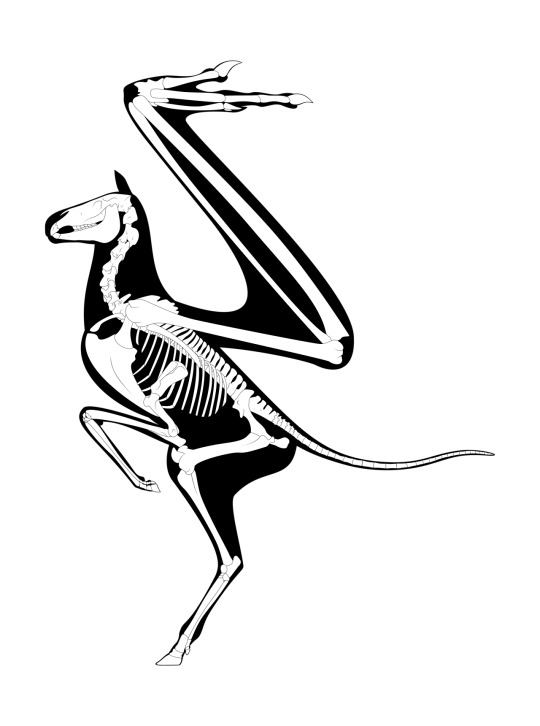
Drferox (collaborating with Shinydinosaurkingdom’s excellent artistic skills~) designed this Pegasus whose front limbs are actually behind the wings, and it actually works!! This may not seem exciting to anyone else, but I’ve literally NEVER seen this idea executed in a way that convinced me it was anatomically plausible, so I’m a little flustered. (if you’d like to see more of Shinydinosaurkingdom’s art and read up on Drferox’s explantion for their design decisions, I’d HIGHLY suggest checking out the link and digging into their blogs!)
Anyways, I’d like to note to other artists here that the ‘front’ limbs on this Pegasus have been shrunk down and pushed quite a-ways back from the front of the body, to the point that they’re useless for locomotion. This gives the chest muscles of the wings the proper room needed to stretch down onto the keel, and for the wings to rotate comfortably. If you want your dragon to be quadrupedal, I still hold that the only way this could work is with the wings behind the front limbs. However, if you like the idea of a bipedal hexapod, then this approach with the front limbs behind the wings seems an excellent idea!
Of course, this is all under the assumption that the wings have fully evolved perfectly into the hexapodal body plan. Evolution does not happen overnight, and it’s perfectly plausible that a set of “pre-wings” would not yet be properly based behind (or in front!) of the front limb shoulders in a certain species’ ancestry. This idea is best described in Swirlix’s discussion of potential hexapodal evolution from the lobe-finned coelacanth. But note, again, that this is a step along the way to powered flight, not the fully-realized structure for powered flight.
Overall Integration
Knowing where to base the shoulders is only half the battle! Remember how I explained in the previous sub-section that locomotive limbs have to throw around the weight of the whole body? This means that the wings’ motion actually drives the shape/structure of practically the entire rest of the body. Locomotion-- and especially flight-- involves the WHOLE body, so ya can’t just slap a set of wings onto any given body and expect that critter to fly. Some bodies need more integration than others, but integration is needed to some degree for ALL bodies.
Now I’m going to list out some things to keep in mind for flighted bodies, building off of some specevo I did for flighted humanoids in the past:
1) To lean slightly forward, even out of flight. This spine arrangement allows a more natural inclination to a horizontal position when flying. This position would extend to the neck as well, which could possibly: 1) be short and attach more towards the back of the skull, so that the head could comfortably look forward during horizontal flight, or 2) be long/flexible and attach to the bottom of the skull, with the elongated curve allowing the head to position itself forward comfortably when the body is horizontal.
This also allows more comfortable spinal flow and positioning for a tail, as discussed in the following point—
2) A tail. Whether bird or bat-winged, a tail is ~usually~ a helpful structure for powered flight. A tail extends the surface area of the wings (whether through tail feathers or membrane attachment) so that the whole body is supported in-flight. Sure, you could have your humanoid’s membrane attach down the legs, but unless you’re planning on drastically changing the humanoid’s leg structure and walking style (thus rendering the term “humanoid” less and less accurate), the legs aren’t going to be entirely suitable for flight in the same way a bat’s or pterosaur’s legs are.
Now, I will admit, there are bats without tails and/or tail membranes. However, you must take into account the human body plan, and how humanoid legs wouldn’t be able to tuck up against the body like a bird, or help with flight like a bat. Besides attaching the membrane to the legs themselves, the best way I can think of to help lift those legs in the air is to hold them up against a fanned tail during flight. Feathered/membranous tails are also a significant plus if you’re planning on giving your humanoids clothing—leg membrane could be a pain to work around compared to tail membrane.
3) A stiff spine with a compact, possibly midsagittally-flattened torso. While certain flyers may have more thoracic/lumbar (the vertebrae of the back/hip regions) flexibility than others, flyers tend to have pretty short/stiff torsos.
Birds probably represent the most extreme in this regard, as their lumbar vertebrae have fused to their hips to form the solid synsacrum, and their furcula/coracoids help hold their chest cavity open. I didn’t mention this in the Basic Anatomy section, but birds also have little projections that extend off the backs of their ribs to overlap proceeding ribs called uncinate processes. These are also believed to help hold the chest cavity open.
This stiffness is important because the chest is the base for wing muscles, which exert heavy thrusting power on the chest cavity during flight. The chest cavity may very well collapse under the strength of these muscles if it wasn’t at least a little stiff/compact. despite not necessarily being a base for wing muscles, the rest of the torso holds enough mass by way of hips+internal organs that the spine in that region needs a bit of stiffness/shortness as well, to help hold all that mass steady. Plus, stiff hips can provide more landing/takeoff stability (which leads into #4 below).
It’s also important for the torso to either be round or be flattened along the midsagittal plane (when looking at the ribcage from a head-on angle).
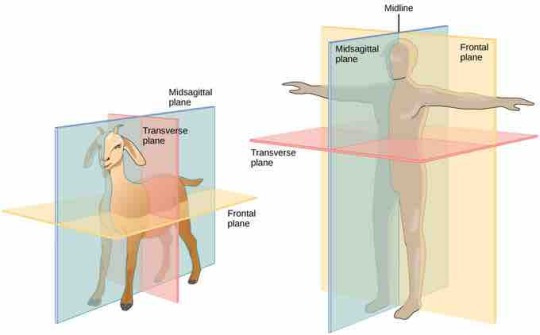
Human ribcages are a bit unique, since we’re flattened along the frontal plane, whereas a lot of other chordates (even other mammals) are flattened along the midsagittal plane due to various biomechanical factors (like how gravity affects quad torsos with legs based underneath the body, etc.).
Flying animals have torsos that are either round (bats, pterosaurs) or flatter along the midsagittal plane (birds, due to their deep keels). This provides a far more stable surface for the all-important wing shoulder muscles to attach to. A torso flattened along the frontal plane like a typical human likely wouldn’t provide the wing muscles a stable enough surface for proper thrust.
4) Digitigrade legs. They don’t necessarily need to be distinctly digitigrade—maybe even semi-digitigrade—but the extra joints can provide more cushioning support to absorb the force of landing and takeoff.
5) Body feather integration, if the wings are feathered. Since this is strictly a wing/flight guide, I’ve only described wing feathering in detail. However, keep in mind that birds are FULLY covered in feathers-- their wings aren’t the only limbs with feathers. If you give your creature feathered wings, there should be a least some form of feathering on the rest of the body too. Some sections could be bare or scaled instead, taking into account their uses (bird legs, for example, often have bare talon pads for gripping, hard-scaled legs, and bare stretchy skin around the eyes, etc.), but birds do have important feathering on the rest of their bodies.
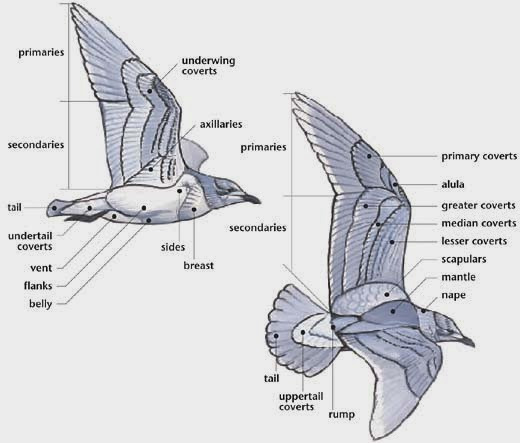
I won’t be discussing these sections of feathers because I’d essentially have to describe an entire bird, just be sure to do some research into this feathering (and take pterylae into account).
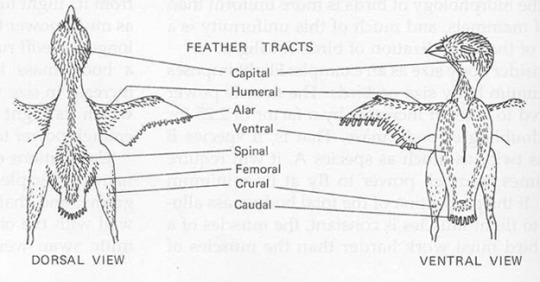
Maybe your creatures won’t look exactly like your base animal (horse, wolf, human, etc.), but they’ll actually be able to FLY once you integrate their wings into their body plans! Plus, I’ve always found animal amalgamations like vanilla-typical pegasus and winged humanoids to be boring as hell—I want creatures that look like their own unique species, not some knock-off brand of another!
But really, the main takeaway here is this—flight is a primarily horizontal endeavor (barring special hovering cases, as we’ve discussed) that exerts heavy forces on the core body. If you want humanoids (or any animal) to fly, they usually need to 1) adapt to a horizontal lifestyle (if they aren’t already horizontal), and 2) have a strong/compact/stable core structure.
If you’d like some more ideas for wing integration, this video is a fantastic 3d overview of basic bird anatomy and some of the adaptions the body has made for flight.
-Mod Spiral
12 notes
·
View notes
Text
Sol (Chapter 2)
A/N: I want to make a correction. In the first chapter, I referenced centrifugal force. Turns out it's actually called centripetal force. My bad. 😑
-----------------------------------------------
For those who didn't read my previous entry, I was sent to the Sol System to study technology that the humans have been developing. My first mission was to go to Termina, a city in space! And now, my next mission was beginning. I was to go to Sol 4, or as the locals call it, Mars. What I would encounter there, really made my mind wonder. As far as I know now, anything is possible. If the humans began teleporting, it wouldn't shock me.
A part of me didn't want to leave Termina. The place was a wonder of impossibility. But, another part of me wanted to see what was so important on Mars that the humans wanted to show me. One thing for sure, Ms. Tsubaki was exited. I asked her what was on Mars that got her so upbeat. She told me that she was going to keep it a surprise for me. Like I needed it to be hidden from me!
As we left in the shuttle, I looked out at the grand cartwheel city and gave it a farewell. The ride took several hours. During that time, Ms. Tsubaki and I talked about mechanics and other things. The time went by really quickly for us. Eventually, the pilot said we reached our destination. It shocked me that time could pass by so fast.
I looked out the window expecting a dead world. From what I researched before ariving, the Sol System has only two inhabited worlds: Earth, the home of the humans, and Europa, home to a primitive race of hexapods. But what I saw shocked me. Instead of a barren world, I saw a planet with oceans and forests that grew on red terrain. Was the info I read incorrect. Than I remembered Termina. Was this yet another myraculous achievement of the humans?! Ms. Tsubaki leaned over and looked with excitement. That confirmed it.
We entered the atmosphere and as we looked, we saw cities everywhere. These were different than you typical cities. They were contained in glass domes with tubes connecting them to each other. We landed and went into a hanger. The air was changed, and we could then leave the shuttle. We walked through a hall and walked out into the city. The city, beyond being located in a dome, was the same as any other. The buildings were smaller, however.
As I spent time on Mars, the cities didn't interest me. Not to understate their impressiveness, but compared to what else was being done on Mars, it was insignificant. What did interest me was what was going on OUTSIDE the cities. From what I heard, Mars was a barren, lifeless world. But just outside was a forest of trees! Mars used to have red skies. It now has blue! What happened?!
Of course, the one with the answers was the always bright Ms. Tsubaki. This according to her, is called terraforming. Literally changing the conditions of a world to make them more compatible with life! This should not be possible! But here it was being achieved right in front of me!
She explained in detail how they were able to achieve it. They first began by producing large amounts of CO2 and releasing it into the atmosphere. This did two things, thicken and heat up the atmosphere. This caused the ice on Mars to melt, which formed the oceans. This also released more gases, furthering the development of the atmosphere. When the conditions were right, they introduced bacteria, lichen, and mosses to Mars. These created the soil that the trees outside now grow in. The trees were a special kind called pines, which grow in cold and mountenous regions of Earth. Perfect for the present conditions.
The project, to my surprise, was incomplete. This was a project that took centuries to do. And it will be centuries before they finish. This is without a doubt the longest project ever undertaken. No other race would spend so much time on a project that won't give immediate results. But, according to Ms. Tsubaki, as technology advances, the time it takes to complete the project may decrease. Maybe it might be finished within my grandchildrens' life-time.
And if the technology is refined, it might only take a century to terraform a world! While the present state of it is limited, it clearly has an amazing future. I now imagine the future full of Mars'. And that is truly amazing.
I now look back at what I have discovered here in the Sol System. A city in space and a world becoming alive! And this is only the beginning! I can only say this. Humanity is going to change the universe forever!
28 notes
·
View notes
Text
5 Best Robot Kits for Adults
In today’s world, technology has gone into the next level and keep progressing in just a blink of an eye. Technology helps our work easier, faster and sufficient. When it comes to age, technology has no age required and category to choose from. Technology is for babies, kids, teenagers, moms, dads, students, workers, adults or more to say, it is for everyone.
When you were a child back then, aren’t you a fan of robot? A thing that moves and have its purpose at the same time is surely fascinating. An Arduino is designed in creating interactive objects or environments. It comes with a number of project examples that you can easily replicate, and a powerful robotics platform that you can program to perform all sorts of tasks. So if you are a fan or robot, it is never too late for you with these “Top 10 Arduino Robot Kits for Adults” that even beginners and experts can learn the electronics, mechanics and software of it. realistic robot dog https://www.robottoyonline.com/realistic-robot-dog-risk-free-pet-therapy
1.Makeblock Ultimate Robot Kit-Blue
The name speaks for itself because it is the Ultimate Robot Kit that has everything you need to construct a robot and you can build more than 10 robots with this Kit. If you are not good in soldering, it is highly recommended for you since it is easy wiring and no soldering required. What more is that it has a Bluetooth connection that lets you control the robot with your smartphone or tablet. It is recommended for beginners and experts because of the Smart Device App Control (Free of Coding), Scratch Programming (Graphical programming tool suitable for your kids) and its Arduino Programming
2.Bioloid STEM Standard Kit
The Bioloid STEM is a kit that has 7 example robots and 21 weeks’ educational material. It is recommended since the STEM standard teaches from basic to advance levels on the electronic, mechanical and programming principles of your robot. By using this kit, centrifugal force, centripetal force, sound, differential gear, steering mechanisms and other more principles will be discussed. This kit is not just recommended by adults but also for students since it has a complete training program that will help you if you are just starting into robotics.
3.Alum Alloy Hexapod Spider for Arduino Six 3DOF Legs Robot Frame Kit Matt Spray
Hexapod Spider robot is common for Arduino but what makes the Alum Alloy Hexapod Spider for Arduino kit different from them is that it is natural looking and has more articulate leg and body design that just looks like a spider since it could move in all direction because of its DOF Leg (Degree of Freedom Leg). It comes from two different colors, black and silver. You only need batteries to power it and you could easily start making your very first robot project. For more Adult Robots : https://www.robottoyonline.com
4.SunFounder Crawling Quadruped Robot DIY Kit for ArduinoPart with Nano Board Remote Control
This Crawling Quadruped Robot kit for Arduino includes everything you need to build a crawling quadruped robot w and control it with a wireless remote control. 18650 rechargeable lithium battery is all you need to power it, it's a four-leg mobile robot and each leg has three joints driven by servos. Using the remote controller included in the kit, you can easily observe and control the robot remotely with the sample sketches provided to robot move forward, backward, left, and right, dance or other more movements. The kit uses the SunFounder Nano board as control. A SunFounder Servo Control Board integrates battery, servo, Nano board, and nRF24l01 wireless module together. This kit is equipped with a SunFounder Mobile Robot Remote Controller so that you can observe and control the robot remotely. It is recommended for small type of projects.
5.Official Arduino Robot Kit
The list will not be completed without the Official Arduino Robot Kit. It is used without soldering required. It easy to use, just pop in the included color LCD screen, load up the Arduino IDE, plug in the USB cable, and you'll be ready to load any one of the included example programs. The robot comes with a number of integrated inputs; two potentiometers, five buttons, a digital compass, five floor sensors, and an SD card reader. It also has a speaker, two motors, and a color screen as outputs, and plenty of prototyping space and TinkerKit connectors for expansion. It even includes 4 rechargeable AA batteries and a charger.
0 notes